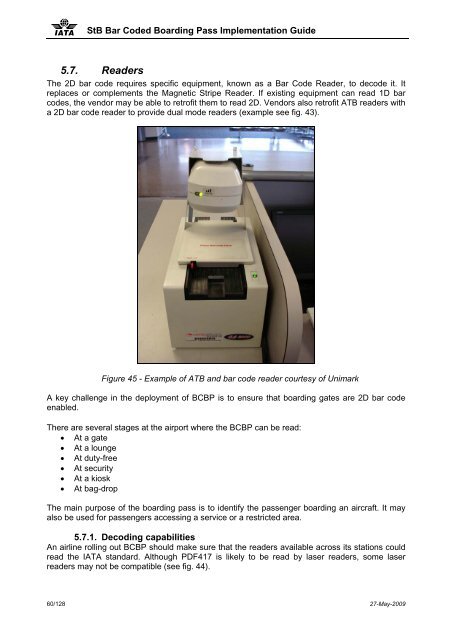Bar-Coded Boarding Passes (BCBP) Implementation guide - IATA
Bar-Coded Boarding Passes (BCBP) Implementation guide - IATA
Bar-Coded Boarding Passes (BCBP) Implementation guide - IATA
You also want an ePaper? Increase the reach of your titles
YUMPU automatically turns print PDFs into web optimized ePapers that Google loves.
StB <strong>Bar</strong> <strong>Coded</strong> <strong>Boarding</strong> Pass <strong>Implementation</strong> Guide<br />
5.7. Readers<br />
The 2D bar code requires specific equipment, known as a <strong>Bar</strong> Code Reader, to decode it. It<br />
replaces or complements the Magnetic Stripe Reader. If existing equipment can read 1D bar<br />
codes, the vendor may be able to retrofit them to read 2D. Vendors also retrofit ATB readers with<br />
a 2D bar code reader to provide dual mode readers (example see fig. 43).<br />
Figure 45 - Example of ATB and bar code reader courtesy of Unimark<br />
A key challenge in the deployment of <strong>BCBP</strong> is to ensure that boarding gates are 2D bar code<br />
enabled.<br />
There are several stages at the airport where the <strong>BCBP</strong> can be read:<br />
• At a gate<br />
• At a lounge<br />
• At duty-free<br />
• At security<br />
• At a kiosk<br />
• At bag-drop<br />
The main purpose of the boarding pass is to identify the passenger boarding an aircraft. It may<br />
also be used for passengers accessing a service or a restricted area.<br />
5.7.1. Decoding capabilities<br />
An airline rolling out <strong>BCBP</strong> should make sure that the readers available across its stations could<br />
read the <strong>IATA</strong> standard. Although PDF417 is likely to be read by laser readers, some laser<br />
readers may not be compatible (see fig. 44).<br />
60/128 27-May-2009
















